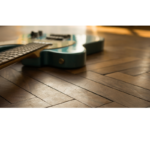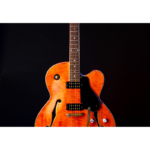When it comes to soloing and improvising on guitar, arpeggios are a secret weapon that can transform your playing. They bring clarity, structure, and melodic sophistication to your solos, allowing you to outline chord changes while adding a polished, professional sound.
But what are guitar arpeggios, and how do you practice them effectively? In this blog, we’ll explore their definition, why they matter, how to master them, and how to integrate them into your improvisation toolkit.
What Are Guitar Arpeggios?
Simply put, a guitar arpeggio is a chord played one note at a time. Unlike a strummed chord, where all the notes sound together, an arpeggio breaks the chord into its individual notes, playing them sequentially.
For example, a C major chord consists of the notes C, E, and G. When played as an arpeggio, you might pick these notes one by one, either ascending or descending. The result is a melody-like line that outlines the chord’s harmony.

Download the ebook “SoloCraft”!
SoloCraft is the ultimate guide to mastering guitar soloing, designed for players of all levels. Packed with step-by-step lessons, pro-level techniques, and real-world examples, SoloCraft teaches you how to navigate the fretboard, craft expressive solos, and unlock your full potential as a lead guitarist. Whether you’re improvising, building speed, or adding emotion to your playing, SoloCraft gives you the tools to solo like a pro.
Download Now
Why Are Guitar Arpeggios Important?
Arpeggios are essential for several reasons:
- Highlighting Chord Tones: In improvisation, arpeggios let you emphasize the most harmonically significant notes, making your solos sound connected to the underlying chords.
- Adding Melodic Interest: They can add fluidity and sophistication to your solos, moving beyond scales into more dynamic phrasing.
- Improved Technique: Practicing arpeggios builds finger dexterity, coordination, and fretboard knowledge.
How to Practice Guitar Arpeggios
1. Start with the Basics: Major and Minor Arpeggios
Begin with simple major and minor arpeggios. Learn the shapes across the fretboard and practice them slowly.
C Major Arpeggio (Root Position):
e|-------------------------8-------------------------------------
B|---------------------8----------------------------------------
G|---------------5-9-------------------------------------------
D|---------5-10-----------------------------------------------
A|---3-7-------------------------------------------------------
E|-------------------------------------------------------------
A Minor Arpeggio (Root Position):
e|-------------------------8-------------------------------------
B|---------------------8----------------------------------------
G|---------------5-8-------------------------------------------
D|---------5-7-------------------------------------------------
A|---3-7-------------------------------------------------------
E|-------------------------------------------------------------
Tip: Start with one shape and practice it in different keys by moving it up or down the fretboard.
2. Use a Metronome
Arpeggios require precision. Practicing with a metronome ensures that you’re hitting each note cleanly and staying in time. Begin at a slow tempo (60 BPM) and increase the speed as your accuracy improves.
3. Practice in Different Directions
- Ascend (low to high): C – E – G – C
- Descend (high to low): C – G – E – C
- Combine: Ascend to the highest note, then descend back.
4. Expand to 7th and Extended Arpeggios
Once you’re comfortable with major and minor arpeggios, move on to seventh chords and their arpeggios, like major 7th (Cmaj7), dominant 7th (C7), and minor 7th (Cm7).
C Major 7 Arpeggio:
e|-------------------------7-8-------------------------------------
B|---------------------8------------------------------------------
G|---------------4-9---------------------------------------------
D|---------5-10--------------------------------------------------
A|---3-7---------------------------------------------------------
E|---------------------------------------------------------------
C Dominant 7 Arpeggio:
e|-------------------------7-8-------------------------------------
B|---------------------8------------------------------------------
G|---------------5-9---------------------------------------------
D|---------5-8---------------------------------------------------
A|---3-7---------------------------------------------------------
E|---------------------------------------------------------------
5. Practice Across All String Sets
Arpeggios aren’t confined to one shape or string set. Learn how to connect arpeggio shapes across the fretboard to unlock new melodic possibilities.

Download the ebook “SoloCraft”!
SoloCraft is the ultimate guide to mastering guitar soloing, designed for players of all levels. Packed with step-by-step lessons, pro-level techniques, and real-world examples, SoloCraft teaches you how to navigate the fretboard, craft expressive solos, and unlock your full potential as a lead guitarist. Whether you’re improvising, building speed, or adding emotion to your playing, SoloCraft gives you the tools to solo like a pro.
Download Now
How to Use Arpeggios in Improvisation
Knowing how to play arpeggios is only half the battle. The magic happens when you start weaving them into your solos and improvisations.
1. Target Chord Tones
When soloing over a chord progression, use arpeggios to target the chord tones of each chord. For example, if you’re playing over C – G – Am – F, you can outline each chord using its arpeggio.
- Over C, play a C major arpeggio.
- Over G, play a G major arpeggio.
- Over Am, play an A minor arpeggio.
- Over F, play an F major arpeggio.
This approach creates a sense of melodic cohesion that connects your solo to the harmony.
2. Combine Arpeggios with Scales
Blend arpeggios with scales like the pentatonic or major scale for more melodic variety. For example:
- Use an A minor arpeggio as a framework, but add passing notes from the A minor scale to create smoother lines.
- Mix arpeggios with chromatic passing tones for a jazzier feel.
3. Create Rhythmic Variations
Play arpeggios with different rhythmic patterns to add interest:
- Triplets: Break the arpeggio into groups of three notes per beat.
- Swing Feel: Add a laid-back, jazzy groove to your picking.
- Syncopation: Accentuate offbeats for a more dynamic sound.
4. Explore Sweep Picking
Sweep picking is a technique where you use a single smooth motion to play multiple strings in an arpeggio. This is common in genres like shred and metal, but it works in other styles too.
Example (C Major Arpeggio with Sweep Picking):
e|-----------------12--------------------------------------------
B|--------------13-----------------------------------------------
G|-----------12--------------------------------------------------
D|--------14-----------------------------------------------------
A|-----15--------------------------------------------------------
E|--12-----------------------------------------------------------
Pro Tip: Start slow with sweep picking and focus on even timing across all strings.
5. Use Arpeggios to Break Out of Ruts
If your solos feel stale, arpeggios can help you explore new melodic pathways. Instead of defaulting to scale runs, use arpeggios to outline the chords, adding a fresh, harmonic dimension to your playing.
Exercises for Mastery
- Chord Progression Practice: Play through a progression like G – Em – C – D using the corresponding arpeggios for each chord.
- Fretboard Mapping: Map out a single arpeggio (e.g., A minor) across the entire fretboard. Play it in all positions.
- Improvisation Challenge: Improvise over a backing track, but only use arpeggios. This forces you to think melodically and connect with the chords.
Final Thoughts
Arpeggios are a game-changer for any guitarist looking to improve their improvisation skills. By mastering their shapes, practicing them consistently, and learning to incorporate them creatively into your solos, you’ll unlock a new level of musicianship.
Looking for more ways to supercharge your solos? Check out SoloCraft, our comprehensive eBook that dives deep into improvisation techniques, from arpeggios to advanced phrasing strategies. And don’t forget to join the Guitar Freaks Hangout on Discord to connect with other players and share your progress! 🎸
If you’re diving into arpeggios, don’t stop there! Check out these related blog posts for more insights:
- Master Guitar Strumming: Tips to Improve Your Rhythm – Strumming is the foundation of rhythm, which pairs beautifully with arpeggio-based lead playing.
- Mastering the Major Pentatonic Scale: A Guitarist’s Guide – Learn how to blend pentatonic scales with arpeggios for melodic improvisation.
- Top 10 Exercises to Improve Your Guitar Speed and Accuracy – Speed and precision are essential for clean arpeggio execution.
These resources will help round out your technique and inspire new creative ideas!

Download the ebook “SoloCraft”!
SoloCraft is the ultimate guide to mastering guitar soloing, designed for players of all levels. Packed with step-by-step lessons, pro-level techniques, and real-world examples, SoloCraft teaches you how to navigate the fretboard, craft expressive solos, and unlock your full potential as a lead guitarist. Whether you’re improvising, building speed, or adding emotion to your playing, SoloCraft gives you the tools to solo like a pro.
Download Now










